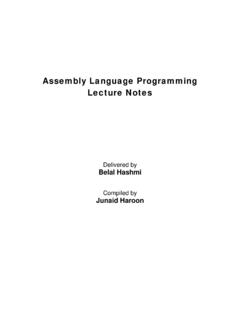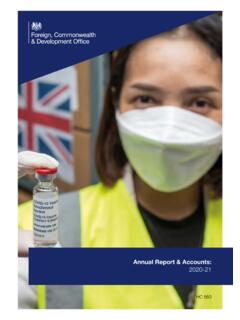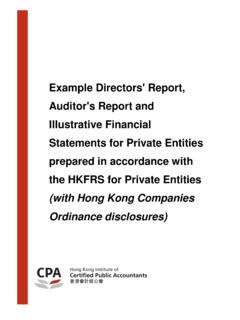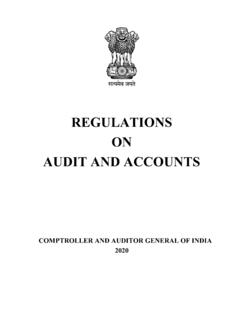Transcription of FUNDAMENTALS OF AUDITING (AN INTRODUCTION) 1 …
1 TABLE OF CONTENTS FUNDAMENTALS OF AUDITING (AN INTRODUCTION) .. 1 AUDITOR S report .. 3 ADVANTAGES & DISADVANTAGES OF AUDITING .. 7 OBJECTIVES & GENERAL PRINCIPLES OF FINANCIAL STATEMENT'S AUDIT .. 9 REASONABLE ASSURANCE .. 13 LEGAL CONSIDERATIONS REGARDING AUDITING .. 15 RIGHTS, DUTIES AND LIABILITIES OF AUDITOR .. 19 LIABILITIES OF AN AUDITOR .. 21 BOOKS OF ACCOUNTS & FINANCIAL STATEMENTS .. 23 STATUTORY REQUIREMENTS REGARDING COMPANY ACCOUNTS .. 36 UNDERSTANDING ENTITY, ITS ENVIRONMENT & RISKS OF MATERIAL MISSTATEMENT .. 42 UNDERSTANDING ENTITY, ITS ENVIRONMENT & RISKS OF MATERIAL MISSTATEMENT (CONT) .. 44 UNDERSTANDING ENTITY, ITS ENVIRONMENT & RISKS OF MATERIAL MISSTATEMENT (CONT.) .. 47 UNDERSTANDING ENTITY, ITS ENVIRONMENT & RISKS OF MATERIAL MISSTATEMENT ( ).
2 50 UNDERSTANDING ENTITY, ITS ENVIRONMENT & RISKS OF MATERIAL MISSTATEMENT ( ) .. 52 ASSIGNMENT .. 57 DOCUMENTING THE INTERNAL CONTROL SYSTEM .. 58 EVALUATING THE INTERNAL CONTROL SYSTEM .. 63 INTERNAL CONTROL QUESTIONNAIRE .. 68 AUDIT TESTS .. 74 SUBSTANTIVE PROCEDURES .. 78 AUDIT EVIDENCE .. 82 SUFFICIENT APPROPRIATE AUDIT EVIDENCE .. 85 TESTING THE SALES SYSTEM .. 89 TESTING THE PURCHASES SYSTEM .. 91 TESTING THE PURCHASES SYSTEM (CONTINUED) .. 93 TESTING THE PAYROLL SYSTEM .. 95 TESTING THE CASH SYSTEM .. 97 TESTING THE CASH SYSTEM (CONTINUED) .. 99 TESTING OTHER SYSTEMS .. 101 TESTING THE NON-CURRENT ASSETS .. 103 VERIFICATION APPROACH OF AUDIT .. 104 VERIFICATION OF ASSETS .. 108 LETTER OF REPRESENTATION (VERIFICATION OF LIABILITIES) .. 111 VERIFICATION OF EQUITY.
3 115 VERIFICATION OF BANK BALANCES .. 116 VERIFICATION OF STOCK IN TRADE AND STORE & SPARES .. 120 AUDIT SAMPLING .. 122 STATISTICAL SAMPLING .. 125 INTERNAL AUDITING .. 128 AUDIT PLANNING .. 131 PLANNING AN AUDIT OF FINANCIAL STATEMENTS .. 134 AUDIT PLANNING (ESTABLISHING OVERALL AUDIT STRATEGY) .. 137 AUDITOR S report ON A COMPLETE SET OF GENERAL PURPOSE FINANCIAL STATEMENTS .. 140 MODIFIED AUDITOR S report .. 146 FUNDAMENTALS of AUDITING ACC 311 VU Copyright Virtual University of Pakistan 1 Lesson 01 FUNDAMENTALS OF AUDITING AN INTRODUCTION What is an Audit? Audit is an independent examination of financial statements of an entity that enables an auditor to express an opinion whether the financial statements are prepared (in all material respects) in accordance with an identified and acceptable financial reporting framework ( international or local accounting standards and national legislations) This view of audit is presented by ISA 200 Objective and General Principles Governing an Audit of Financial Statements.
4 The phrases used; to express the auditor s opinion means that the financial statements give a true and fair view or have been presented fairly in all material respects. True and fair presentation means that the financial statement are prepared and presented in accordance with the requirements of the applicable International Financial Reporting Standards (IFRS) and local pronouncements/legislations. What we can understand as the essential features of an audit from the above definition and explanation are as under: An auditor involves in examination of financial statements, the auditor is not responsible for the preparation of the financial statements. The end result of an audit is an opinion to assist the user of the financial statements.
5 AUDITING therefore relies heavily on professional judgment, not merely on the facts. The auditor s opinion makes reference to true and fair or fair presentations but true and fair is again a matter of judgment. It is not precisely defined for the auditor. In order to make the user of the auditor s report able to feel confident in relying on such report , the auditor should be independent of the entity. Independent essentially means that the auditor has no significant personal interest in the entity. This allows an objective, professional view to be taken. You will note that this is a wide concept of an audit which can be applied to any entity, not just to limited companies. However, in this course, we are concerned primarily with audits of limited companies (often known as statutory or external audits).
6 Any other audit applications will be clearly indicated for you in the text. Why is there a need for an audit? The problem that has always existed at the time when the manager reports to the owners is that: whether the owners will believe the report or not? This is because the reports may: a. Contain errors b. Not disclose fraud c. Be inadvertently misleading d. Be deliberately misleading e. Fail to disclose relevant information f. Fail to conform to regulations The solution to this problem of credibility in reports and accounts lies in appointing an independent person called an auditor to examine the financial statements and report on his findings. A further point is that modern companies can be very large with multi-national activities. The preparation of the accounts of such groups is a very complex operation involving the bringing together and summarizing of accounts of subsidiaries with differing conventions, legal systems and accounting and control systems.
7 The examination of such accounts by independent experts who are trained in the assessment of financial information is of benefit to those who control and operate such organizations as well as to owners and outsiders. Many financial statements must conform to statutory or other requirements. The most notable is that all company accounts have to conform to the requirements of the Companies Ordinance 1984 but many other FUNDAMENTALS of AUDITING ACC 311 VU Copyright Virtual University of Pakistan 2bodies (like: Charities, Building Societies, Financial Services business etc) have detailed accounting requirements as required by the relevant legislations.
8 In addition all accounts should conform to the requirements of International Financial Reporting Standards (IFRSs). It is essential that an audit of financial statements should be carried out to ensure that they conform to these requirements. What is the distinction between AUDITING and accounting? Relationship between AUDITING and accounting AUDITING and accounting are closely connected but both are separate activities. The directors of a company are responsible for establishing books of accounts that will accurately record financial information and that are used for preparing the annual financial statements. It is similarly the responsibility of the directors to adopt consistent and appropriate accounting policies in order to prepare and present the financial statements.
9 The financial statements have to comply with national legislative requirements and International Financial Reporting Standards (IFRSs). Accounting is the process of recording, classifying, summarizing and reporting financial information in a logical/systematic manner for the purpose of decision making. To provide relevant & reliable information, accountants must have a thorough understanding of the principles and rules that provide the basis for preparing the financial statements. In AUDITING the financial statements, the concern is with determining whether the presented financial statements properly (true and fair) reflect the financial information that occurred during the accounting period. Since auditors are primarily concerned with the end result of this work do the financial statements show a true and fair view?
10 In order to arrive at their conclusion the auditors must have a deep knowledge and understanding of accounting (including applicable accounting standards) and in practice, the directors will consult with the auditors as to appropriate accounting policies to follow. Many financial statement users and members of the general public confuse AUDITING with accounting. The confusion results because most AUDITING is concerned with accounting information, and many auditors have considerable expertise in accounting matters. The confusion is increased by giving the title Chartered Accountant to individuals performing a major portion of the audit function. Who can be an auditor? For appointment as auditor of: a) a Public Company or b) a Private Company which is a subsidiary of a Public Company.

















